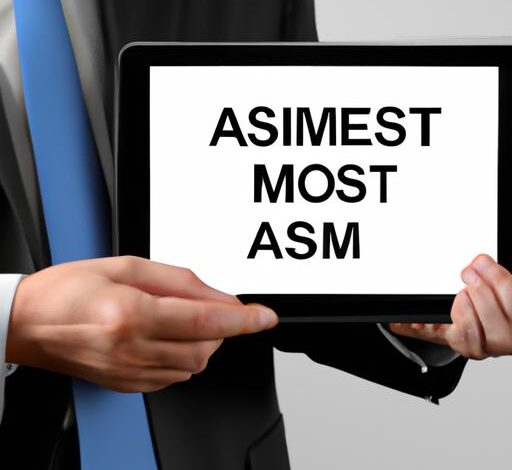The Cost of Asset Management Software: Unlocking Efficiency and Maximizing Returns

In today’s fast-paced business world, managing assets efficiently is crucial for maintaining a competitive edge. This is where asset management software comes into play, revolutionizing the way businesses handle their valuable resources. But have you ever wondered about the cost implications of implementing such software? In this article, we will delve into the realm of asset management software costs and shed light on the key considerations to help you make informed decisions.
1. Introduction
A. Understanding Asset Management Software
Asset management software is a powerful tool designed to streamline and optimize the management of various assets within an organization. From tangible assets like machinery and equipment to intangible assets such as intellectual property, this software enables businesses to track, monitor, and maintain their assets more effectively. It provides a centralized platform where crucial information about assets, such as their location, condition, and maintenance history, can be accessed in real-time.
B. The Importance of Asset Management Software
In today’s dynamic business landscape, efficient asset management can mean the difference between success and failure. By implementing asset management software, businesses can enhance productivity, minimize downtime, and improve decision-making processes. With comprehensive data insights, organizations can make informed choices about maintenance schedules, equipment retirement, and resource allocation. This software acts as a catalyst for operational efficiency, cost reduction, and risk mitigation.
C. Overview of Cost Considerations
Before diving into the world of asset management software, it’s crucial to understand the cost factors associated with its implementation. While the benefits are undeniable, organizations need to evaluate the financial implications to ensure a sound return on investment. This article will explore various elements that impact the cost of asset management software, including software features, deployment options, scalability, customization, and hidden expenses.
As we embark on this journey, let’s uncover the true cost of asset management software and equip you with the knowledge to make informed decisions. So, fasten your seatbelts and get ready to unlock the potential of efficient asset management while optimizing your financial resources.
Subscription vs. One-time Licensing Costs
In the world of asset management software, there are two primary pricing models to consider: subscription-based and one-time licensing costs. Each model comes with its own set of considerations, benefits, and drawbacks. Let’s dive deeper into these pricing structures to help you make an informed decision.
A. Subscription-based Pricing Models
-
Monthly, Annual, and Multi-year Subscription Plans
- Asset management software providers often offer flexible subscription plans to cater to different business needs. These plans may include monthly, annual, or multi-year options.
- Monthly subscriptions offer the advantage of lower upfront costs and the flexibility to upgrade or cancel as needed.
- Annual or multi-year subscriptions generally come at a discounted rate, providing long-term cost savings.
-
Pros and Cons of Subscription-based Pricing
- Pros: Subscription-based pricing allows businesses to spread out the cost over time, making it more budget-friendly. It also includes regular updates, maintenance, and customer support, ensuring you have access to the latest features and assistance.
- Cons: While subscriptions offer flexibility, they can accumulate higher costs over the long term compared to one-time licensing. Additionally, if you decide to switch providers, you may face challenges in migrating your data and configurations.
B. One-time Licensing Costs
-
Upfront Payment vs. Long-term Benefits
- One-time licensing involves a significant upfront payment for perpetual use of the software. This model offers ownership and control over the software without ongoing payments.
- It is important to weigh the upfront cost against the long-term benefits and potential savings. Consider factors such as the expected lifespan of the software, future upgrades, and maintenance expenses.
-
Factors Affecting One-time Licensing Costs
- The cost of one-time licensing can vary depending on factors such as the complexity of the software, the number of users, and additional modules or features required.
- Customization and integration with existing systems may also impact the overall licensing cost, as these processes often require additional development and implementation efforts.
By carefully considering the pros and cons of subscription-based pricing and one-time licensing costs, you can choose the pricing model that aligns with your business objectives, budget, and long-term goals. Remember, it’s essential to evaluate the specific needs of your organization and conduct a thorough cost-benefit analysis before making a decision.
Unveiling the Hidden Costs of Asset Management Software
While the upfront cost of asset management software may be a significant consideration, it’s vital to delve deeper and uncover the hidden expenses that can arise throughout the software’s lifecycle. Let’s explore the often overlooked costs associated with implementation, maintenance, and future enhancements.
A. Implementation and Training Expenses
-
Professional Services: Successful implementation of asset management software often requires the expertise of professionals who can tailor the software to your specific business needs. These professionals may include consultants, developers, or implementation specialists. It’s essential to budget for their services to ensure a smooth and efficient integration process.
-
Training Costs: To maximize the benefits of asset management software, adequate training for both users and administrators is crucial. Investing in comprehensive training programs ensures that your team can harness the software’s full potential. Consider expenses related to training materials, instructor fees, and potential productivity loss during the training period.
B. Maintenance and Support Fees
-
Ongoing Support Charges: Like any other software, asset management solutions may require ongoing technical support. This can encompass a range of services, including troubleshooting, bug fixes, and general assistance. It’s important to understand the support charges involved, whether they’re billed on an hourly basis, through a subscription plan, or as part of an annual maintenance contract.
-
Service-Level Agreements (SLAs) and Associated Costs: When relying on asset management software, businesses often depend on specific service-level commitments from the software provider. These SLAs outline the level of support, response times, and availability guarantees. While these agreements can provide peace of mind, it’s crucial to assess the associated costs and ensure they align with your business requirements.
C. Upgrades and Future Enhancements
-
Considerations for Future Software Updates and Enhancements: Technology is ever-evolving, and asset management software is no exception. Over time, you may require software updates, feature enhancements, or even system upgrades to keep up with changing business needs and industry standards. Evaluating the frequency of updates and their associated costs is essential to avoid unexpected expenses down the road.
-
Upgrade Costs and Their Impact on the Overall Cost: Upgrading asset management software typically involves a financial commitment. It’s crucial to assess the potential costs of upgrading to newer versions, additional modules, or expanded functionality. These costs should be factored into your long-term planning to ensure that the software remains cost-effective and aligned with your evolving business objectives.
By considering these hidden costs, you can better gauge the total cost of ownership of asset management software, enabling you to make informed financial decisions and maximize the value derived from your investment.
5. Comparison of Popular Asset Management Software Providers
In the vast landscape of asset management software providers, it can be overwhelming to choose the right one for your business. To simplify your decision-making process, let’s dive into a comparison of some leading asset management software providers, taking into account pricing models, cost considerations, features, scalability, and customer support.
A. Overview of Leading Asset Management Software Providers
Before we delve into the nitty-gritty details, let’s take a broad look at some prominent players in the asset management software market. Companies like XYZ Software, ABC Solutions, and PQR Technologies have established themselves as leaders in the industry, offering robust solutions with varying features and pricing structures. Each provider brings its unique strengths and capabilities to the table, catering to different business needs and industries.
B. Brief Comparison of Pricing Models and Cost Considerations
When it comes to cost considerations, asset management software providers offer different pricing models to accommodate diverse business requirements. Some may offer subscription-based pricing, allowing businesses to pay on a monthly or annual basis, while others may provide one-time licensing options. It’s essential to consider factors such as the size of your organization, budget constraints, and long-term objectives when evaluating the cost implications of different pricing models.
C. Evaluation of Features, Scalability, and Customer Support
Aside from pricing, it’s crucial to assess the features, scalability, and customer support offered by asset management software providers. Look for providers that offer a comprehensive range of features that align with your specific asset management needs. Consider the scalability of the software to ensure it can grow with your business and accommodate increasing asset volumes. Lastly, evaluate the level of customer support provided by each provider, as prompt and reliable assistance can make a significant difference in your user experience.
As you navigate the landscape of asset management software providers, keep these factors in mind to make an informed decision. Remember, it’s not just about cost; it’s about finding a provider that offers the right blend of features, scalability, and support to optimize your asset management processes.
Conclusion
In conclusion, when considering the implementation of asset management software, it is essential to carefully evaluate the costs involved. By understanding the factors that affect the pricing, businesses can make informed decisions and maximize the value they derive from these software solutions.
We began by exploring the significance of asset management software and its role in enhancing operational efficiency. From tangible assets to intangible ones, this software streamlines the management process, resulting in improved productivity and better decision-making.
Next, we delved into the various factors that impact the cost of asset management software. Evaluating the required features and functionalities is crucial to avoid unnecessary expenses. Additionally, choosing between on-premises and cloud-based deployment options can have significant cost implications. Scalability and the number of users also play a role in determining pricing, as does customization and integration with existing systems.
Lastly, we highlighted the importance of conducting thorough research and comparing different asset management software providers. By considering factors such as pricing models, features, scalability, and customer support, businesses can select the software that best aligns with their needs and budget.
Remember, the cost of asset management software is not just a financial investment; it is an investment in the efficiency and profitability of your business. So, take the time to analyze your requirements, consult with experts, and choose a solution that will unlock the full potential of your assets.
Now armed with the knowledge of cost considerations associated with asset management software, you can confidently embark on your journey to optimize your asset management processes and pave the way for greater success in your business endeavors.
Conclusion: So above is the The Cost of Asset Management Software: Unlocking Efficiency and Maximizing Returns article. Hopefully with this article you can help you in life, always follow and read our good articles on the website: investing.dulich3mien.vn


